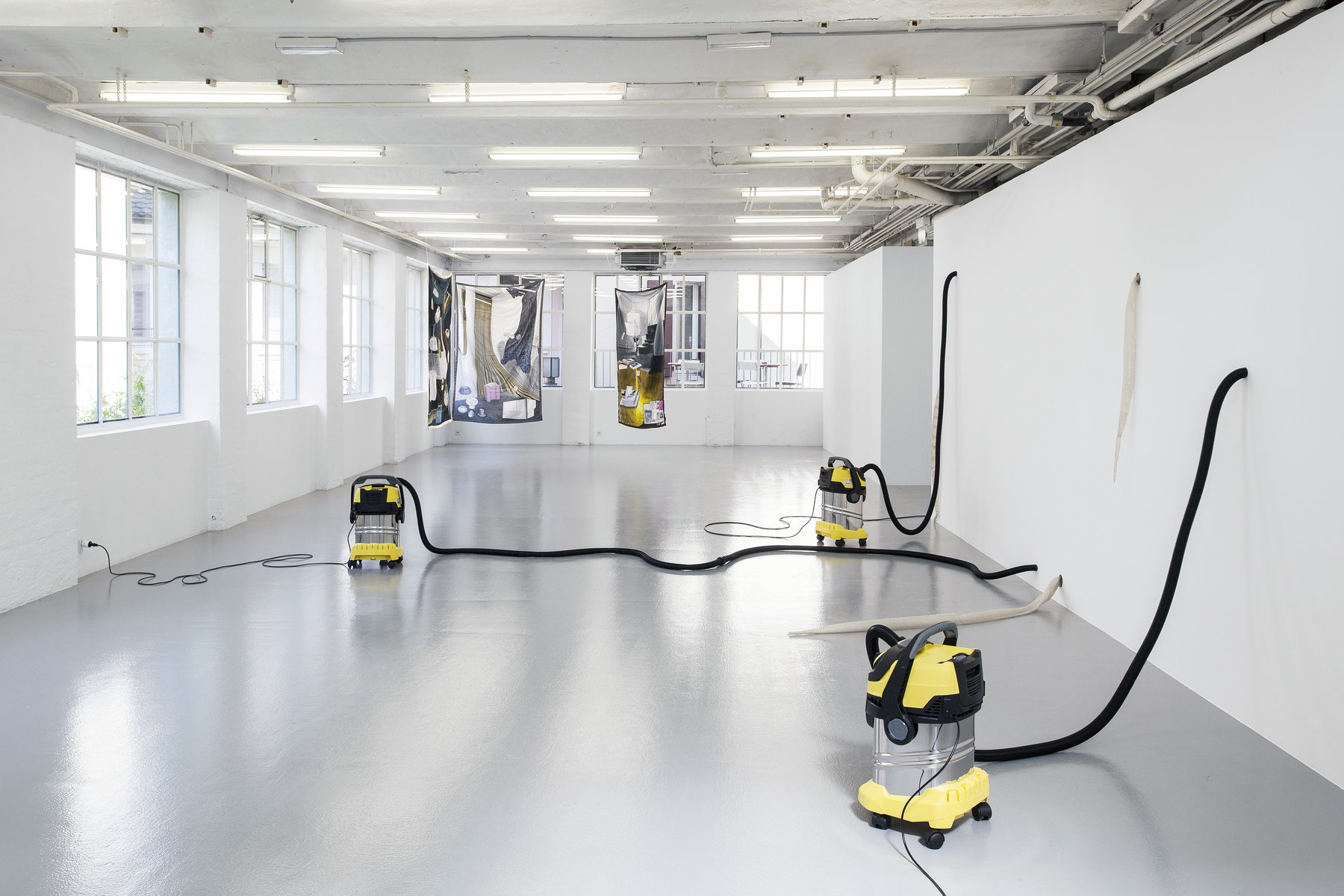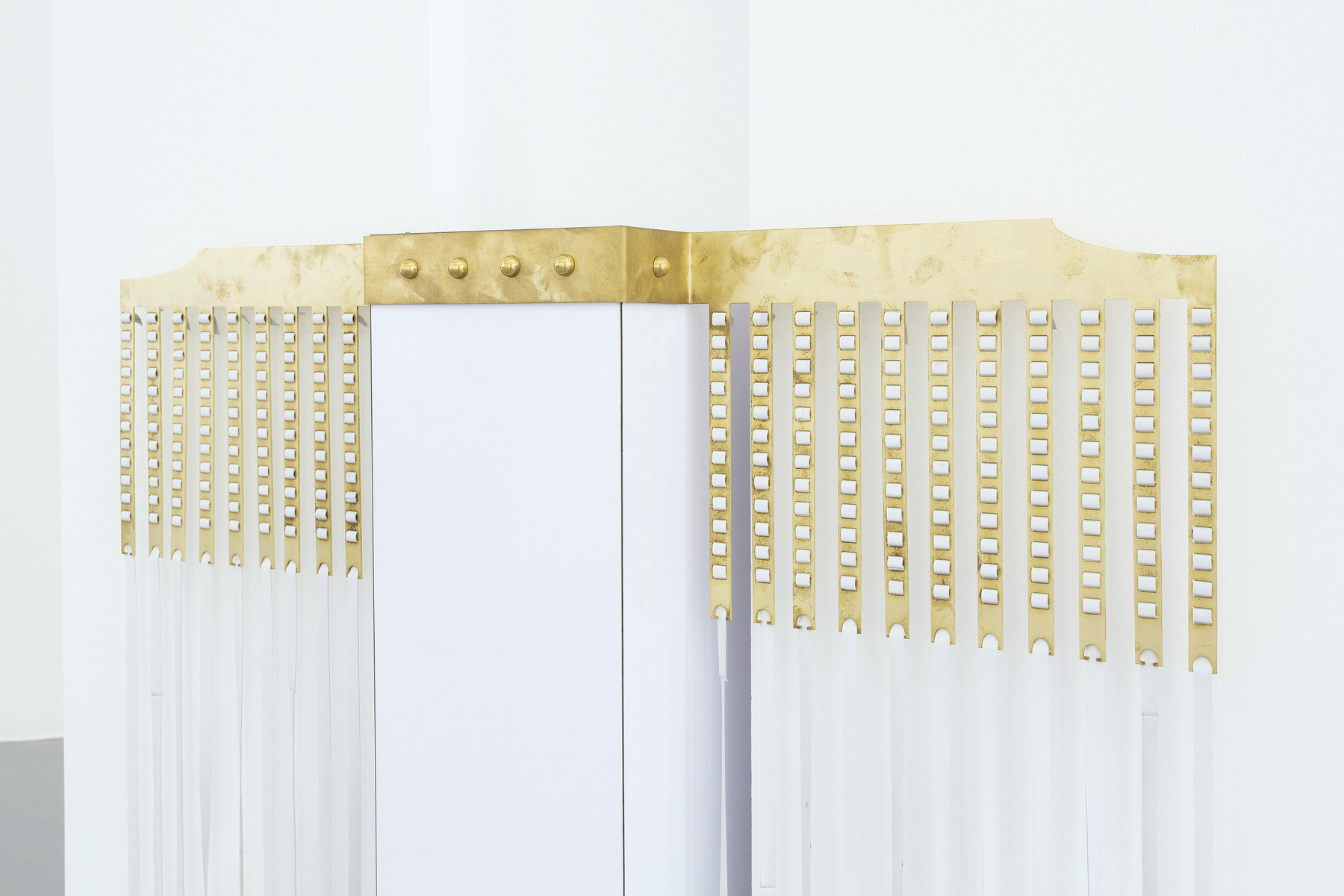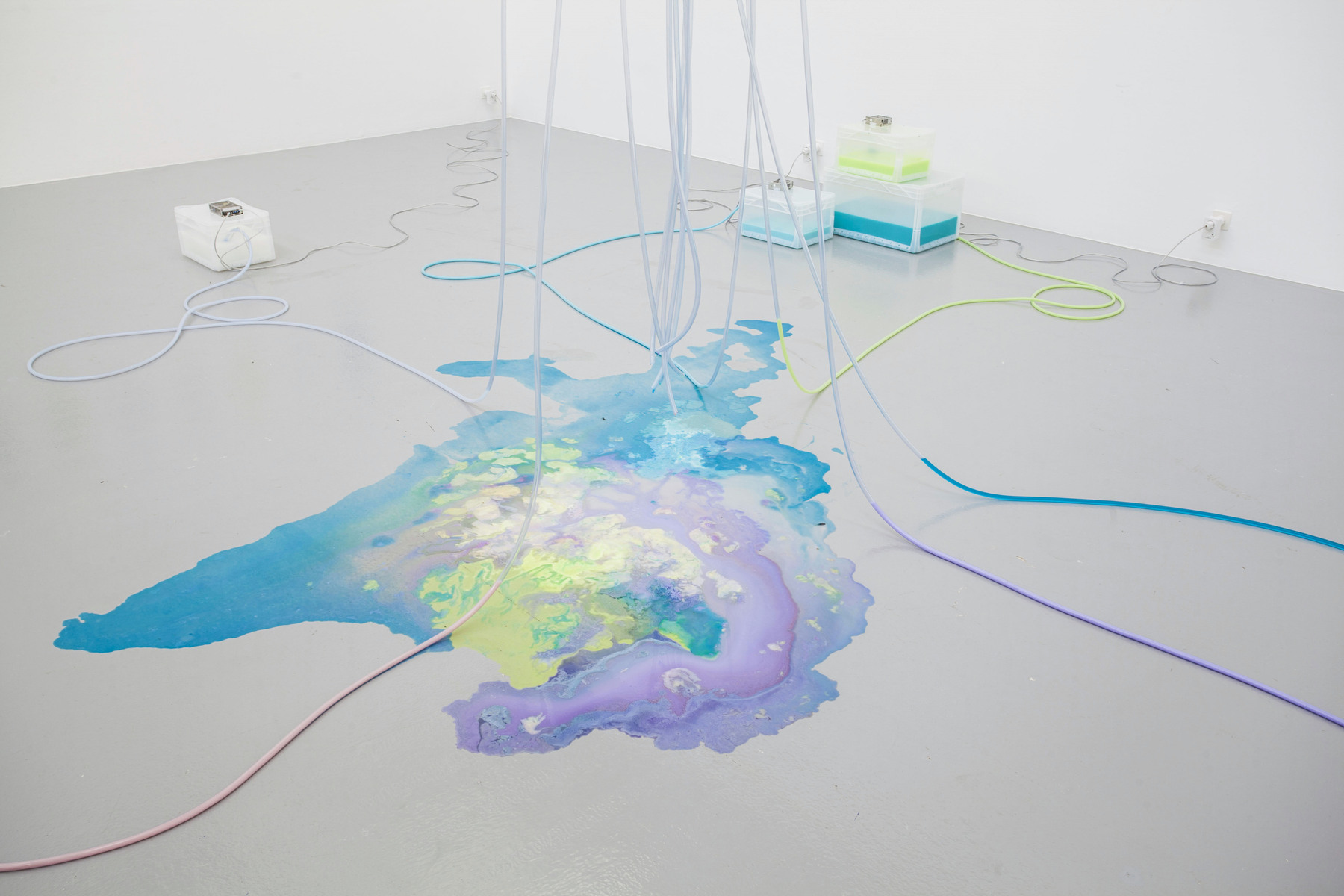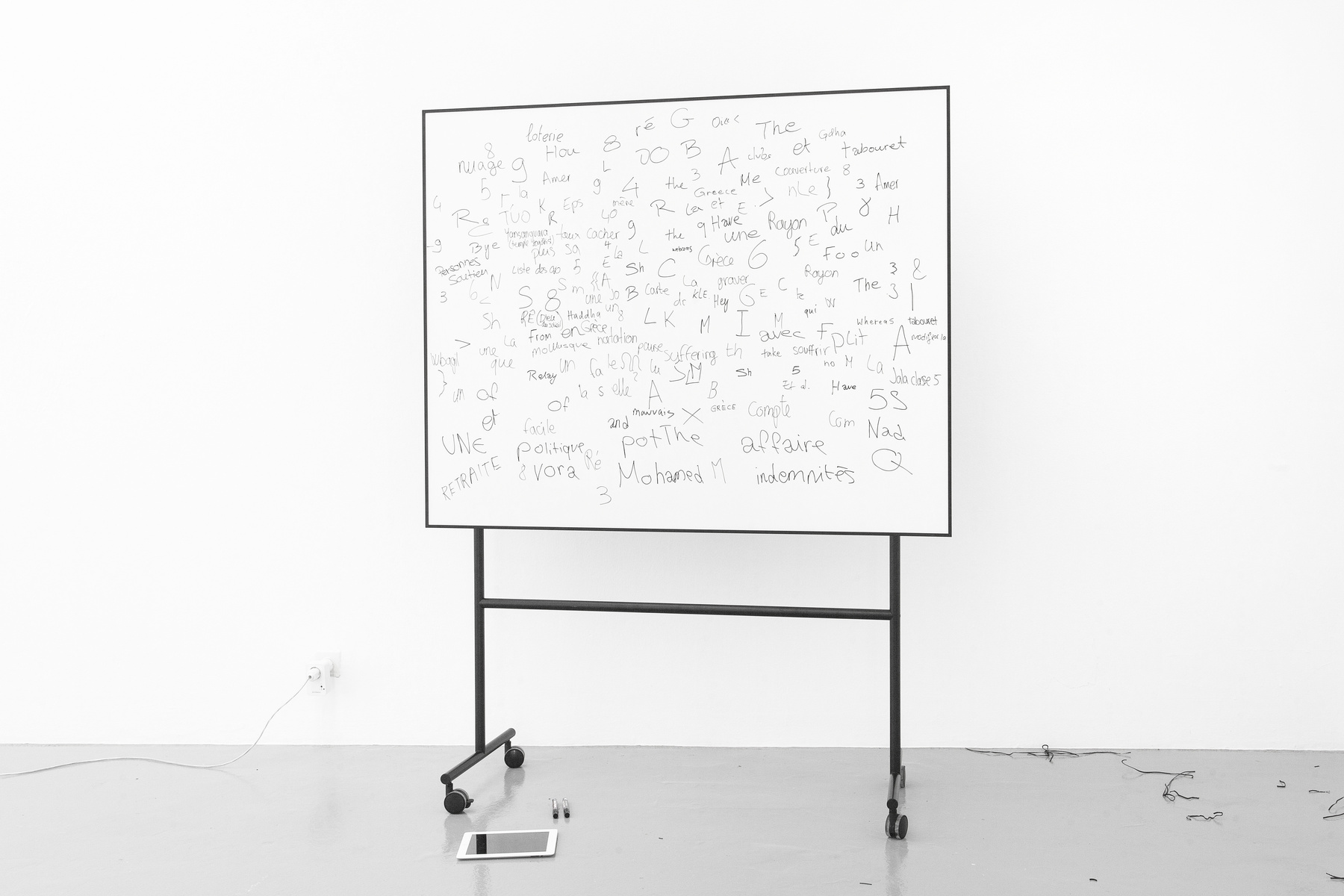Artists: Alessandro Agudio, Heike Karin Föll, Cécile Krähenbühl, Sarah Ancelle Schönfeld
Exhibition title: Keep Being Touched
Venue: CAN Centre d’Art Neuchâtel, Neuchâtel, Switzerland
Date: June 9 – July 9, 2017
Photography: all images copyright and courtesy of the artists and CAN Centre d’Art Neuchâtel
Some reckon that the famous prehistoric stencil paintings of hands on the walls of caves are actually a trace of surface rituals… Those rituals would have sought to connect the practitioner with the “other world” through gesture, flat surface to flat surface, skin to rock face. There is an advantage to this esoteric hypothesis in that it questions our relationship to surfaces, which is determined by a dualistic thinking that inescapably sets up an opposition between surface and essence, body and mind, outside and inside, devaluing the former in favor of a certain depth. The tendency to believe that shattering the surface of things allows one to see what lies hidden behind that surface is deceptive; no interiority is preserved from the exterior, and there remain differences of density, relative thicknesses that involve sensation and perception. Moreover, skin springs from a common embryonic development it shares with the nervous system, that is, a union of depth and the superficial that is rooted in its very genesis… Touch seems to precede all the other senses and is posed as a language that is so immediate and pervasive it in fact struggles to be grasped.
The artists featured in the present show indulge as much in playing with appearances as revealing skin and everything we call surfaces to be connectors, interfaces, ways for information to circulate. Through very different approaches, they present us with objects that are both familiar and surreal, the strangeness of which plays with our perception of them to the point of opening up the poetic possibilities of their functions and uses. The works on display question the nature and treatment of surface, skin, membrane, page, and screen, their permeability and impermeability, involvement, distortions, and wounds.
Alessandro Agudio
The young Italian artist Alessandro Agudio is based in Milan and has exhibited in art centers and galleries both in Italy and abroad (London, New York, and Paris). Agudio draws his inspiration from his immediate environment, the fitness center where he has been working for a longtime. Fitness centers all seem to feature the same installations and equipment, i.e., a bar, solarium, rooms equipped with large mirrors and good sound systems, lots of plants, and on the walls fake abstract paintings and slick colorful digital images. It is indeed these elements that appear in Agudio’s work, though they play out in a new and mysterious way. The artist also lavishes great attention on the rendering of the surfaces of his objects. Often they are painted in faux marble or imitation stone, or in other pseudo-natural materials. When Agudio talks about his works, he likes to point out the fact that while they look great at first, altogether pleasing to the eye, the humbleness of their materials and the hollowness of their structures quickly becomes obvious to the viewer. Agudio even goes so far as to speak about traps and trompe l’œil to describe the effect of his work on the viewer.
Agudio is showing several pieces in the exhibition, including Konturella, a kind of platform painted in faux pink marble. This platform holds a number of objects, including a small decorative plant and a stylized sculpture of a cat. We also see laid out there a cast form that vaguely suggests a kitchen sink or part of the skeleton of some imaginary animal on which three speakers are posed. Konturella indeed broadcasts to the room digital pop, a kind of supermarket music. For a number of reasons, the piece is emblematic of Agudio’s work in general. This object, this multimedia setup, seems to summarize by itself alone not only the kitschy design that can be found everywhere, but also, and paradoxically, all the poetry, humor, and imagination the artist deploys.
If Alessandro Agudio shines a rather cruel light on the industry that has sprung up around wellbeing and looking good, he is also an artist who has decided to appropriate his environment and to transform it into something else altogether. And sometimes he also simply reminds us that if at first glance surfaces are flat and devoid of any depth, on them an infinite play of perspectives can be projected for those who know how to take a closer look.
Sarah Ancelle Schönfeld
Sarah Ancelle Schönfeld (1979) studied at the University of Visual Arts in Berlin. She has shown internationally, notably in Germany, Italy, the United States, Brazil, and Japan. The artist is currently living and working in Berlin. The artist’s wide-ranging practice encompasses sculpture, performance, installation, and photography. She looks to extend the limits of both the mind and materiality, and explore the connections between culture and nature, spirituality and space, the brain and the body. The artist finds inspiration as much in indigenous perspectivism as in the spiritual dimension of science and technology. Schönfeld elaborates various scenarios that question the production of truth and knowledge, constituting and reproducing our human „self “ in the world
For the exhibition at CAN, Schönfeld is showing pieces that she associates with several bodies of work brought together under the terms Devices, Oracles, and Labs. The Devices are improbable, trickster objects, machinelike assemblages of everyday items that bring together technology and magic. With her Oracles and Labs, the artist creates systems based on hacking the integrity of already existing and established concepts and techniques, describing a different possible perspective on reality, and opening metaphysical dimension of machines.
Among the pieces she has contributed to the exhibition, Schönfeld has created a new version of her installation Serpent Ritual. The piece refers to traditional rituals associated with serpents – such rituals are found in every culture, the snake symbolizing both danger and a cure. The artist, drawing inspiration from the ethymological senses of ‘Spirit’, uses a molted snake skin, animating it literally together with a machine-version of the wind/ breath.
Heike-Karin Föll
Heike-Karin Föll (1967) is a graduate of the Staatliche Akademie der Künste, Stuttgart, the Freie Universität Berlin, and the Universität der Künste Berlin. She has exhibited in a wide range of cities, from New York and Berlin to Zurich, Basel, and Montreal.
Föll creates paintings, artist’s books, collages, and installations. The great delicacy, even discretion, of her works has doubtless something to do with the modesty of the materials she employs, notably the page and paper. The objects are linked through shared references and allusions. Text circulates between works, coming from logbooks she keeps, notes, scribblings, typewritten words, a collection of impressions, poems, images, clippings, favorite passages from novels, excerpts of letters, scans, dream protocols, theoretical writings… These unstable elements are brought together according to a constellational logic.
The works featured in the show are collages in which Föll has blended various historical references with the ordinary private world of day-to-day existence. She is thus able to transcend the burden of authority these references possess and lighten them through the delicacy of her pieces. The artist’s skill in recording and filing away these coexistent dimensions is fundamental to her work (she focuses on noting the presence of art incorporated in daily reality; Föll, moreover, teaches embedded art in Berlin).
The artist creates a play of tensions between revealing literary and artistic references and retaining information. What level of privacy does the artist maintain with her work? Föll’s pieces work their way in between the interior and the exterior, between what one can know or not know of an artist or a work of art, between what she or he reveals or does not reveal. Can one penetrate the meaning of the work of art or more broadly the mind of someone, or does one merely graze an unstable system of connections?
Cécile Krähenbühl
Cécile Krähenbühl is a young fashion designer from French-speaking Western Switzerland. At the invitation of Anne Minazio, the director of the Genevan art space HIT, Krähenbühl has crafted covers that display motifs from and references to works and exhibitions associated with HIT. Handmade and employing artisanal stitching techniques, the covers feature very free depictions of scenes of show openings and works installed in the art space. Since their creation, the covers have mostly been used by the venue to cover benches where visitors can sit.
The cover is a space, a specific surface. But it is first of all a surface that can be shaped and molded, and which assumes various looks according to the situation. The cover can be laid out flat on a bed, can be seen folded on a shelf, can cover part of a piece of furniture, emphasizing its form and volume. It may also be seen hugging the shapes of a body, following its curves and movements. It is also seen floating in the air, as in the show at CAN. The cover is a soft and fluid object-surface that reminds us indeed of skin.
To depict images of exhibitions and artworks on a support like the cover is intriguing. The situation allows us to evaluate the series of plays of surface that occur in art centers and art in general. In viewers’ eyes, the exhibitions that have been held at HIT are juxtaposed with and added to the show at CAN, placing those viewers before a multitude of spatial and temporal layers.
Sarah Ancelle Schönfeld, Serpent Ritual (1-3) switched on, 2017
Sarah Ancelle Schönfeld, Serpent Ritual (1-3) (detail), 2017
Sarah Ancelle Schönfeld, Serpent Ritual (1-3) (detail), 2017
Sarah Ancelle Schönfeld, Serpent Ritual (1-3) (detail), 2017
Cécile Krähenbühl, Couverture #1 CERAMIQUES, Couverture #3 BIBLIOTHEQUE, Couverture #2 HORS- D’OEUVRE, 2016
Cécile Krähenbühl, Couverture #1 CERAMIQUES, 2016
Cécile Krähenbühl, Couverture #3 BIBLIOTHEQUE, 2016
Cécile Krähenbühl, Couverture #2 HORS-D’OEUVRE, 2016
Cécile Krähenbühl, Couverture #2 HORS-D’OEUVRE (detail back), 2016
Alessandro Agudio, White Fringe Boot – SN, 2017
Alessandro Agudio, White Fringe Boot – SN (detail), 2017
Alessandro Agudio, Konturella, 2017
Alessandro Agudio, Konturella (detail), 2017
Heike-Karin Föll, surrealist sex (#1 – #9), 2015
Heike-Karin Föll, surrealist sex (detail), 2015
Heike-Karin Föll, surrealist sex (detail), 2015
Sarah Ancelle Schönfeld, Antibacterial Ground Reading, 2017
Sarah Ancelle Schönfeld, Antibacterial Ground Reading (detail), 2017
Sarah Ancelle Schönfeld, Antibacterial Ground Reading (detail), 2017
Sarah Ancelle Schönfeld, Antibacterial Ground Reading (detail), 2017
Sarah Ancelle Schönfeld, Antibacterial Ground Reading (detail), 2017
Alessandro Agudio, Flashes (Guby and Coca), 2017
Alessandro Agudio, Flashes (Guby and Coca) (detail), 2017
Sarah Ancelle Schönfeld, Alien Linguistic Lab, 2017
Sarah Ancelle Schönfeld, Alien Linguistic Lab (detail), 2017
Sarah Ancelle Schönfeld, Alien Linguistic Lab (detail), 2017
Sarah Ancelle Schönfeld, Alien Linguistic Lab (detail), 2017
Sarah Ancelle Schönfeld, Alien Linguistic Lab (detail), 2017
Sarah Ancelle Schönfeld, Alien Linguistic Lab (detail), 2017



































